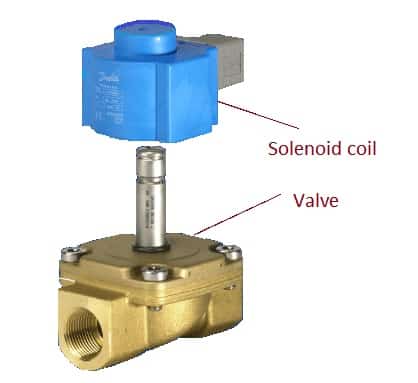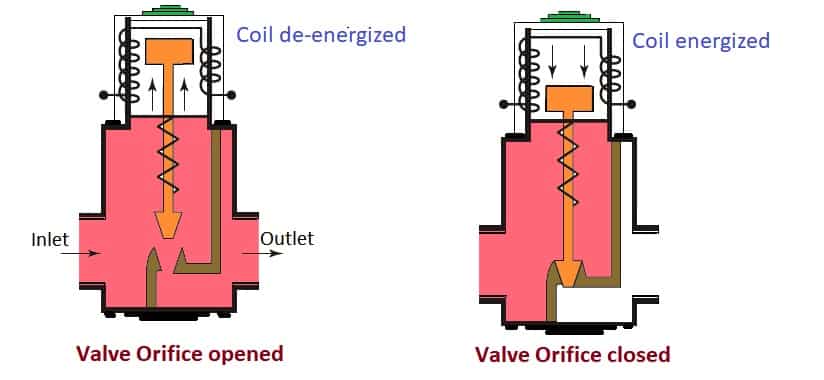The term Common failure mode of the solenoid valve is used to refer to the different ways in which a component of the solenoid valve may fail. The solenoid valve is an electrically operated device. There are various reasons for failures of solenoid valves during solenoid valve operation. We will discuss some of the common failure modes of the solenoid valves in this article.
What is a Solenoid Valve?

A solenoid valve does not regulate flow. It controls the flow of liquids or gases in the fully open or fully closed position.
The solenoid valve is a valve that closes by gravity, by pressure, or by the action of a spring. It opens by the movement of a plunger operated by the magnetic action of an electrically energized coil, or vice versa.
A solenoid valve consists of two distinct parts, but integral actuating parts:
- Solenoid (Electrical Coil)
- Valve body
An electromagnet produces lines of magnetic force when electric current flows through the coil of the electromagnet. Thus, the electromagnet is important for the design of automatic control. The reason for this is, it is possible to create or eliminate the magnetic field when activating or deactivating an electrical current.
We can use the solenoid valve to control the flow of many different fluids, giving due consideration to the following parameters in the construction of the valve.
- Pressure
- Temperature involved
- Viscosity of fluid
- The adaptability of material used
These valves generally operate either fully open or fully closed, although there are applications where flow is controlled in a linear fashion.
Also, there are solenoid valves that can work with alternating current (AC) or with direct current (DC) and use different voltages and operating cycle durations,, depending on their construction or shape.
Down below are the failure modes of solenoid valves. Before going through them, let us understand how a solenoid works.
- Strange sounds
- The opening does not take place
- Valves that close partially
- Drawbacks with coils
- Bad installation
How does the solenoid valve work?
A solenoid valve generates a magnetic field of a certain intensity when the electric current pass through the coil. The solenoid valve has a plunger made of ferrous metal. The magnetic force produced in the coil attracts the plunger towards the center of the coil. Thus, the movement of the plunger provides the necessary movement for the valve operation.
The solenoid valve has two modes of operation, either fully open or fully close. There is no middle stage for valve movement. Therefore the solenoid valve system is not suitable for flow control applications.

Solenoids remain open till the electrical power is cut off and the electromagnetic field from the solenoid disappears. At this time, spring or spring pushes the plunger back to its original position, changing the state of the valve.
Depending on the duty cycle of the valve, it is possible to use coils that are capable of working continuously or in cycles of a determined duration. The continuous working duty solenoid valve is usually more expensive.
The followings are the common failure modes of the solenoid valve.
Strange sounds
On opening & closing of the solenoid valve, it creates an audible sound that is similar to a hammering or humming sound. The sound may be disturbing or irritating.
The followings are the reasons for sound during the opening and closing of the solenoid valve.
- The minute gap between the solenoid coil and plunger stem.
- Looseness of lock-nut of Coil
- Differences between outlet and inlet pressure inside the system cause a wandering sound.
- High pressure of the liquid passing through a small hole in the pipe causes water hammering.
The opening does not take place
It is one of the most reported problems of solenoid valves and its origin is due to
- Uneven Pressure
- Power Failures
- Dirt in the lower part of the diaphragm
- Low voltage to solenoid valve coil
- Corrosion
- Missing Components
- Burns in a coil
The variety of possible causes can be inconvenient and cause users to waste a lot of time searching for solutions. The ideal is to reduce the inconvenience to solve it.
We have to evaluate during the process are the
- Diaphragm
- Its spring
- Flow control setting
- Coil Power
- Valve inlet
- Solenoid outlet port
- Bleed port
Common Failure Modes of solenoid valve–Valve Closes partially
Partially closing of the solenoid valve is the problem that mainly happens due to pressure differences.
The following reasons contribute to the partial closing of the solenoid valve.
- Manual Override
- Damage to armature tube
- Residual magnetism in the magnetic circuit of the solenoid coil
- Damage or inversion in the seats
- Absence of some components
The solenoid valve may go into an intermediate stage if the supply air pressure is low. To move the solenoid out of the intermediate state, close the air valve and turn off the machine.
Common Failure Modes of solenoid valve –Drawbacks with coils
There are various problems that can occur to the coils, for example,
- Burning or
- Staying cold on power turn on
Its causes are usually slow coil armatures, short circuits, high temperatures of the media, whether liquid or gas and inadequate voltages.
It is advisable to ensure that an incorrect voltage supply does not occur. First, check the compatibility of the power supply with the coil-rated supply voltage. Check the presence of humidity inside and mount a new coil if necessary. Also, replace the armature if it is in bent or damaged condition, and check the compatibility of the valve with the media.
Remember to store the solenoid valves in a cold or conditioned place for later use of the solenoid valve.
Common Failure Modes of solenoid valve – Bad installation
It is important that the valve is installed in the correct direction. On it, an arrow indicates the direction of the flow of the medium in your body.
We need to install a solenoid valve according to the direction of the arrow marked, and not reverse it, otherwise, it will cause the valve pressure to reverse and not close as it should.
It is important that it must be generally installed horizontally. In some cases a 30 ° tilt is possible. The valve will become unreliable if installed vertically.